A Brutal Day Tour in Tbilisi
Friendly Ge says that their Brutal Tbilisi Urban Exploration tour takes visitors on a “journey of discovery [to] uncover the hidden corners of Tbilisi and reveal its secrets.” Always keen to discover the hidden corners of a city and the fact that Wander-Lush, a blog by Emily Lush, an Australian who lives in Kutaisi, Georgia, lists the tour as one of the ‘must do’ activities in Tbilisi, I sign up before we leave Sydney.
Starting our Day Tour in Tbilisi
Jonah, our guide, meets us in the reception of our hotel. He’s a political scientist and lecturer at the University. Guiding is his side-hustle, one he loves as he gets to share his passion for Tbilisi with visitors.
As we drive through the streets of Tbilisi to the city’s outskirts, Jonah points out places of interest. The building shaped like “mysterious pipes’ was to be a concert hall. Then there were plans for a food hall and more recently a wine museum. Like many things in Tbilisi, it was never completed and none of those plans came to fruition. The building stands empty.
Georgia has a Complicated History
Our destination is some way away, and Jonah uses the time to explain some of Georgia’s complicated history. Born in 1994, he describes the “nightmare” of his childhood, a description I have heard more than once by people his age. He says that “there was no water, no gas, no electricity” and “paramilitary gangs roamed the streets” and “people disappeared.”

The Rose Revolution and resignation of Eduard Shevardnadze in 2003 signalled the end of the Soviet leadership era. We drive past the main Cathedral of the Georgian Orthodox Church. It dominates the city skyline, the golden dome standing out from surrounding buildings. Completed in 2004, it’s the “biggest, not the oldest” cathedral, says Jonah.
The Chronicles of Georgia
We pull up at the foot of a small hill, topped with what some refer to as “Georgia’s Stonehenge.” Two wide Roman columns stand on either side of the stairs leading up to the massive sculpture. One is ‘broken’, the other solid. The towering sculpture, which started construction in the 1980s is not yet complete. It consists of 16 square pillars, each about 35m tall. The columns are lined with copper and bronze relief sculptures.
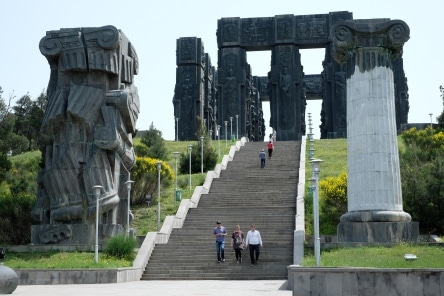

Each column forming the Chronicles is divided into three sections. The lower square panels refer to bible stories Jonah points out historical Georgian figures in the middle section, and scenes from Georgian history and cultural life in the top section.
Sometimes less is more. Jonah knows so much that after a while I can’t take it all in.
Other Reasons to Visit the Chronicles of Georgia
Another reason to visit the Chronicles of Georgia is the view. Walking through the Chronicles to the other side, we have a broad view of the suburbs of Tbilisi and an artificial lake called The Tbilisi Sea. It was built in the 1950s to provide water for agriculture.

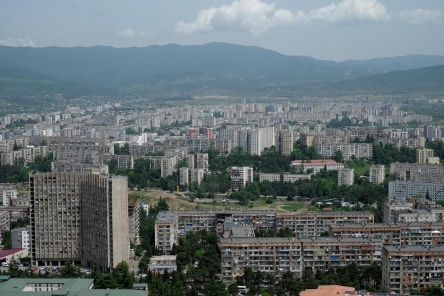
Jonah encourages us to look carefully at the high rise ‘apartment’ buildings to guess at which were built in the Soviet era and which are newer. He explains that during Soviet times, couples were given one apartment. Often couples divorced in order to get a second apartment.
We have a quick look inside a small church. It is being restored. Bright bold religious scenes decorate the internal walls.
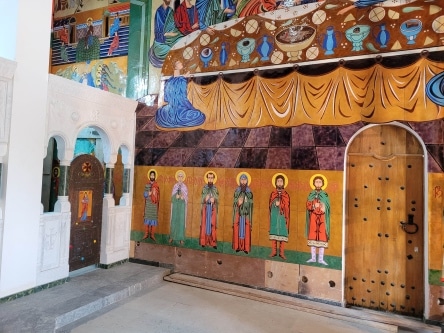
The Day Tour in Tbilisi Continues
Back in the car, we drive through what Jonah calls a “dormitory suburb” where the average monthly income is around 1500 Georgian Lari (about AU$870). The buildings look shabby and poorly maintained.
Our next stop is a series of three reservoirs on the top of another hill. Across the valley we can see the towering Chronicles of Georgia. The reservoirs no longer store water. One was to be converted into an Archaeological Museum. Work started on the museum, but never finished.
The Archaeological Museum
Weeds grow through cracks in the stairs leading up to an imposing Soviet-style stone frieze above the ‘museum’ entrance. New metal framed windows and a pot plant indicate life on the left-hand side of the stairway. There’s also a satellite dish for television reception.
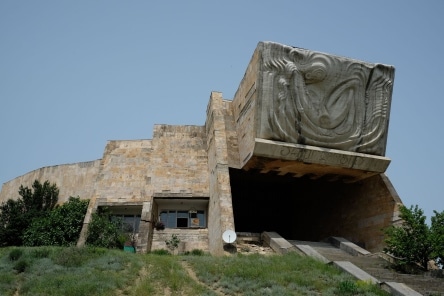
I peer through the locked doors into the ‘reception’ area of the museum. Dusty plastic bags filled with pottery fragments rest on trestle tables. There are piles of cardboard boxes on the floor and under the tables. I notice a doorbell. When I suggest pressing it, Jonah takes charge and does the deed. He says that security is unlikely to let us in.
A man emerges from an internal side door. He lives – or has an office – on site. A badge on his dark clothing identifies him as security. He’s not about to let us in and won’t even allow me to take a photograph through the open door.
Becoming an Urban Explorer
We follow Jonah along a rough track around the side of the museum to the second reservoir. No longer curious travellers, we’ve become “urban explorers.” Following BK, I fold myself into a wide metal pipe to enter the reservoir. The air is damp and the floor slippery. Light enters the space through a few cracks in the roof and a central skylight. Our eyes take a few minutes to adjust to the darkness.
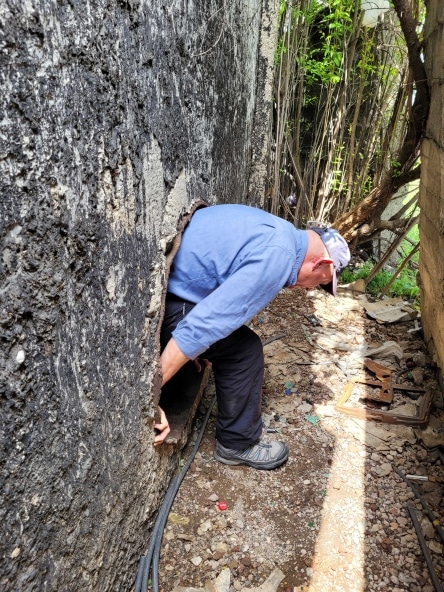
Weird circular brick structures take up a large part of the central space. Jonah doesn’t know what they are there for. There’s a pile of old broken furniture which he says “just arrived one day.”
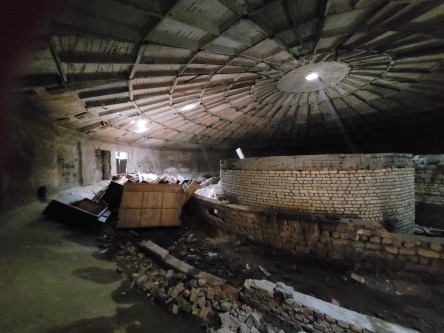
Inside a Tbilisi Reservoir
Entry to the third reservoir is via an old metal ladder. Jonah isn’t sure if we’re up to it. We are. Following his instructions to go down one at a time and hold onto the sides not the steps, I go first. Rust comes off on my hands. The ladder, attached to the wall, suddenly bends away from me. I wonder if this really is such a good idea.
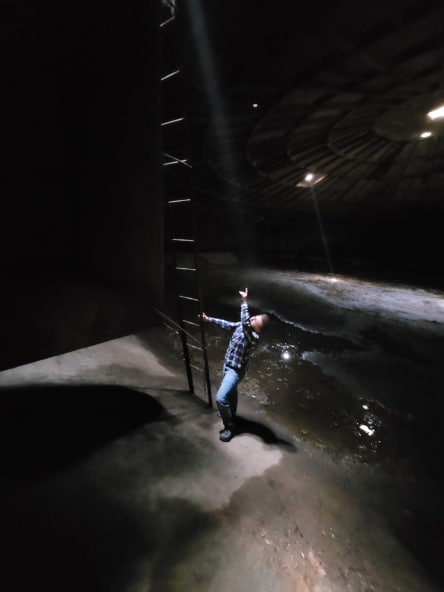

It’s cool down in the reservoir. Our voices echo as water drips onto the muddy floor. Jonah offers to demonstrate the good acoustics. He sings a well-practiced “The House of the Rising Sun.” It seems incongruous in this setting and I suggest he sings something Georgian.
He, with our driver, stands hand over heart while they sing the Georgian National Anthem.
Returning to the car, Jonah tells us we’ve been somewhere most people in Tbilisi don’t know even know exists.
More Soviet Architecture
The car park in front of the Bank of Georgia is chock-a-block with cars. We can’t enter the building but do get out for a good look. The building looks like a series of giant Jenga blocks carefully placed one on top of the other in an open square construction. An example of communist construction, originally built in 1975 for the Ministry of Highway Construction, it was acquired by the Bank of Georgia in 2007.

On our way to the Saburtalo district of Tbilisi, we see a group of young people cleaning windscreens. Jonah explains they are gypsies and beggars who “work in teams.” He says that they often don’t have birth certificates, don’t exist officially and don’t go to school.
We’ve been going for quite some time now and I’m hungry. Perhaps my questions and Jonah’s enthusiasm for his topic has taken us over time. Fortunately, when we park the car at our next stop, I spy a small grocery store and buy a couple of bananas to keep me going. I really should have brought some snacks with me.
The Tbilisi Skybridge
The residential development known as the Skybridge is built in a hilly area. A series of lifts connect and footbridges connecting apartment blocks enable residents to get from the lowest level to the top level. Stepping onto the metal footbridge, we walk to the first of three apartment blocks. A couple of residents look at us curiously as they pass.

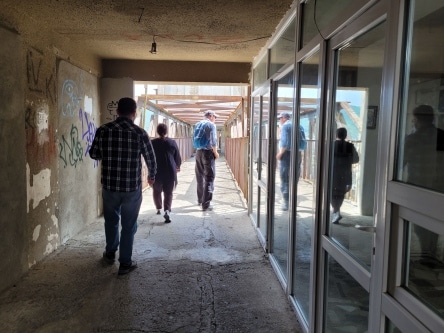
We enter the elevator to get down to the ground floor. Jonah drops 20 tetri per person into the coin slot. It has to be a 20 tetri coin. Any other coin will jam the lift! A woman downstairs monitors the lift ‘traffic’ via an old CCTV system ensuring that everyone pays.

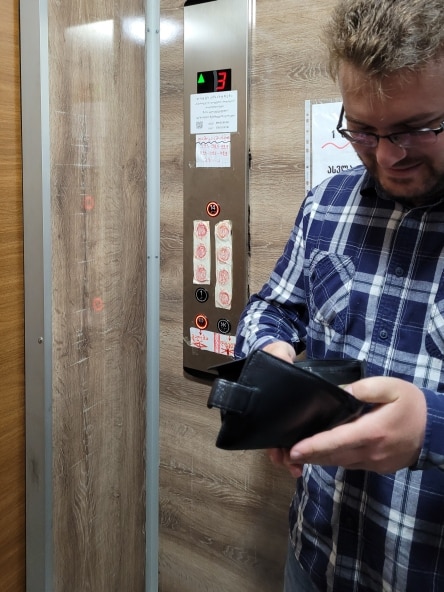
The Lift Monitor for the Tbilisi Skybridge
Her flat is on the ground floor. She isn’t home. Beside the closed door are a couple of cupboards, two old chairs and a few ragged pot plants. We exit the building to take a look from the outside. When we go back, the woman’s door is open and she invites us into her apartment.


Not really an apartment, it’s a rather small room with a couch as a bed and a gas ring for cooking. On the wall is a picture of Stalin alongside pictures of Jesus and Mary.

She shows Jonah a television screen on a desk near the door. Two of the four quadrants on the screen show the outside of the lifts. The other quadrants are blank. Next to the television is an old microphone which she uses to talk to people in the lift.
Another Unfinished Building in Tbilisi
The University is our next stop. Here colourful murals brighten the concrete walls of the brutalist architecture. A whole ‘new’ wing of the university stands unfinished and abandoned.


From here, we cross a bridge over the valley to a group of dormitory apartments. They are home to people internally displaced by the wars in Abkhazia and Ossetia.
Home to Internally Displaced Persons
We follow a small man into a tiny lift. It clatters up to the eleventh floor where we step out into a dark foyer lit only by a single globe next to a sturdy door. Loud music blasts from behind the door. Washing hangs from a line strung along the passage. I walk along the dark corridors of rough unfinished concrete wondering about the lives of those living here. Jonah says the apartments are nice inside. I’ll have to take his word for it.

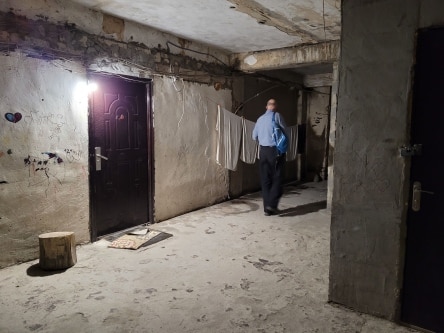
A woman follows us down the passage. Thin, with an expressionless face, she drags her slippered feet along the ground, avoiding eye contact. She knocks on the door to one of the apartments. No one answers and she retreats the way she came.

Outside, a group of men play a game of dominoes. They’re using an abacus to score and are ok with me taking their photo. A bottle of chacha (homemade spirit) sits on the edge of the table. One of their mates left it for them.
Our Day Tour in Tbilisi Comes to an End
Our last Soviet experience of the day is to cross back to the other side of the valley. This time by cable car. The old soviet cable car has been restored, and I’m confident that it’s safe.

Today has been extraordinary and memorable to say the least. Today I stepped out of my comfort zone more than once as a curious traveller and urban explorer and been richly rewarded. The Brutal Tbilisi Urban Exploration tour has shown me a side of Tbilisi and Georgia that many travellers miss.
Useful Information
- Find out more about the Brutal Tour here
- For a walking tour in Tbilisi exploring hidden architectural gems see this post
- And for a tour of Gori in a Lada, see this post
- We also did a great Food Tour of Georgia. Read more here

Great story! But being pedantic, I reckon the word “brutal” should be “brutalist”. That’s the architectural use , or so I’ve heard
Thanks Graham, I hear you, but that’s what they call their tours. I’ve edited the references to brutal architecture!
I would like to visit Georgia one day ,especially now after reading your post.. Fingers crossed
I’d go back tomorrow, Kristina, but there are so many places to visit and too little time!
You provided a very interesting glimpse into soviet architecture. I love seeing the inside of the lift monitors home and can only imagine experiencing the guys singing in the reservoir.
Yes, Bernadette, the lift monitor is an interesting person. I’d love to hear her story.